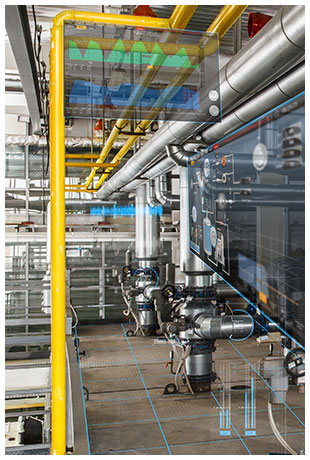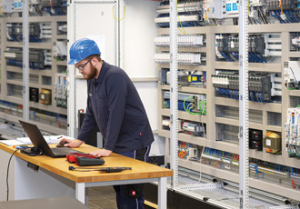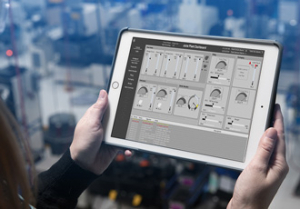What will the next generation of SCADA look like?

The death of SCADA as a technology was predicted by pundits around 30 years ago, they said it would have no place in the plants and factories of the future. However, look at it now. Contrary to this the technology has constantly evolved in line with user requirements, and indeed continues to evolve. Paul Hurst, Managing Director of Products4Automation (P4A) vendors of the Movicon SCADA Suite explains what the next generation of SCADA will bring to the party.
Despite all the talk of ‘lights out factories’, there will always be a need for people to interact with machines and processes, to visualise operations and respond to performance indicators. Currently this usually happens locally, but there is a trend towards more and more remote access. Going forward, remote operation may become the norm.
We are already seeing SCADA beginning to move from PC screens to remote devices. In the future, we could see projection onto a pair of safety glasses or the use of a virtual reality (VR) headset. Putting our imaginations into overdrive, maybe one day SCADA info will be delivered straight to the operator’s cortex. But for now the need is to put information on a screen and allow operators to navigate through it and use the interface to make control adjustments.
What will define the next generation of SCADA then, and how will it continue to drive the evolution of plant integration and process control? In short, the key innovations of this next generation SCADA are how it goes about collecting data and storing it so that it can be aggregated, processed and transmitted to the screen for display.
The latest SCADA products are platforms with a suite of modules and options, rather than fixed hard-coded proprietary programs. This configuration makes them very flexible and scalable. Further we are seeing important innovations in communications and networking, cross-platform compatibility, database flexibility and visualisation.
A key driver for modern communications and networking is OPC UA (open platform control, unified architecture), and next generation SCADA products will increasingly be based on client/server architectures that use information models defined by OPC UA standards, exploiting the WCF (Windows Communication Foundation) technology in the communications infrastructure. Not only does this drive new levels of openness in the way SCADA is integrated with the plant automation and IT infrastructure, it also massively simplifies the way communications are established with control devices.
OPC UA includes a large number of I/O drivers, so is capable of managing protocols of all the most widely used automation devices.
This vendor neutral approach also extends to cross-platform compatibility, with next generation SCADA offering web client solutions using HTML5 technology. This makes it simple to enable remote access to field applications with guaranteed performance and cross-platform integration. Furthermore we are increasingly seeing dedicated apps specifically designed for smartphones and tablets, making it even easier to securely control and monitor plants and processes over the web.
Database flexibility is becoming increasingly important in SCADA applications, and next generation products will use their own virtual file system (VFS) to render applications independent from persistent data models. This gives users the capability and flexibility to connect to relational databases, use cloud computing or use standard XML files on disk for historical logging and archiving process or project data.
From an operator interaction perspective, perhaps some of the most important developments are in the visualisation capabilities of next generation SCADA. New user interface concepts use the latest generation of DirectX graphics acceleration to fully exploit the exceptional quality of WPF/XAML (Windows Presentation Foundation / eXtended Application Markup Language) vector graphics technology in 2D and 3D. This can make the visualisation of processes on the screen clearer and more intuitive.
At the same time, today’s tablet and smartphone generation of users now expect features such as multi-touch and gesture control from the consumer environment to be standard within the plant control world. In next generation SCADA, a diverse selection of objects and symbol libraries now provide native support to the very latest multi-touch and Kinect user interface technologies with Windows 10 styling and navigation.
We can expect further benefits too with technologies based on 64-bit.NET code to guarantee reliability, openness and performance. Plug-in models ensure full customisation of modular systems and integration of new customised modules. These frameworks can offer a full suite of functional modules capable of guaranteeing rich and complete supervision and user interface solutions with total openness and expandability.
Some of this may sound futuristic, but all these functions and capabilities are available today in the Movicon.NExT SCADA platform. This was created using the best and most innovative technologies to ensure users reap the maximum benefits from supervision, HMI, control and plant intelligence systems. The result is that the Movicon.NExT satisfies all of today’s emerging communications and interoperability requirements, while providing a platform on which users can build on the goals of Industry 4.0.
Similar articles
More from Products4Automation
- Will 5G be a game changer for SCADA? 18th December 2019
- Controlling a textiles factory from home 22nd November 2019
- Increase production flexibility with better batch management 8th October 2019
- Cruise passengers stay cool with HVAC control systems 28th August 2019




 technology at Jacobs Vehicle Systems.JPG)







Write a comment
No comments